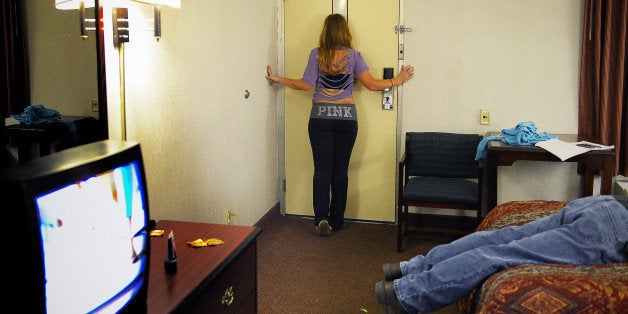
Whether people are aware of it or not, sex trafficking is a serious issue in several major U.S cities.
Despite law enforcement efforts and preventative laws, Hispanics are largely affected by this problem.
Data from a new study at the Urban Institute reveals that Hispanics are increasingly populating–and running–underground sex businesses, and though they’re not as organized as other ethnicities in the illegal sex trade, the crime rings are growing.
“The Hispanic side is still about the money. There is some organization there, but it’s not anything like the Asian organization which is truly organized crime that ranges clear back to China,” said a San Diego Law Enforcement Official in the report.
”It’s not by chance that they pay somebody just to come over here, it starts there. They pay whoever they pay and that person is linked up with someone over here, and whoever they get in contact with, that whole chain is linked up together,” he explained.
In some cities, such as in Miami, the underground sex trade is predominantly Hispanic, with most of the women and men from Mexico, Honduras, El Salvador, and Guatemala, being forced into the underground due to smuggling debts.
Some of these, however, offer no other reasonable options but to sell their bodies to cover personal debts, and are considered to have entered the sex trade through a personal choice. Meanwhile others are sold into it by family members.
At the same time, other Hispanics–men and women–are often operating a number of underground sex businesses, involved in everything from prostitution to child pornography.
Dallas, Texas, for example, has a number of Hispanic-owned and -operated massage parlors that act as a cover for women who voluntarily participate in prostitution.
This practice has become common in Dallas where there’s been a huge increase in the number of Hispanic women sold into the sex business.
Most women are sold into the sex trade world by their mothers who feel a need to feed their drug addictions.
But the issue of Hispanics in the underground sex trade goes even further–they are also the primary customers of underground sex rings, especially in cities like Washington, D.C.
Nationwide, 80 percent of clients for Hispanic sex rings are Hispanic men.
The psychology of prostitution
There is little to explore behind the reason for sex trafficking; those who operate such institutions are in it for the money.
There’s always a profit to be made where there’s a demand for something, and sex has always been a powerful force in humankind.
For clients of underground sex rings, however, it isn’t about money.
Often, there’s a misconception held by the client that the women involved in such practices are not only there willingly, but enjoy the work they do.
The client isn’t aware of the fact that many women in sex rings are coached to always please the client, to fake orgasms and to do whatever it takes to put on a smile on their faces. If they did otherwise, they’d be exposing themselves to being hurt or to having their families targeted.
According to research from the University of Portland, the average male in the United States who visits a prostitute is usually likely to have served in the military, only slightly less likely to be married and white, and only slightly more likely to have a full-time job and be more sexually liberal.
Despite the common assumption that men who pay for sex are looking to dominate or hurt a woman, data suggests this is not the case; most men paying for sex truly believe a prostitute wants or desires sex on a level incomparable to most other women–including wives and significant others.
“While it is noteworthy to recognize that the 1 percent of adult men who paid for sex in 2010 still result in a large number of customers,” said Christine Milrod, a study researcher at the University of Portland.
“There’s no credible evidence to support the idea that hiring sex workers is a common or conventional aspect of masculine sexual behavior among men in the United States.”
But what about those women who are in the sex trade by force? Are they seeing the same types of customers as women who voluntarily enter into prostitution?
The answer to these questions is elusive, as few studies have been done evaluating clientele for voluntary and involuntary sex businesses. According to experts from Psychiatric Times, however, the belief that underground sex rings are places of violence and horror is no myth.
“Prostituted women are unrecognized victims of intimate partner violence by pimps and customers,” states the report from Psychiatric Times.
“Pimps and customers use methods of coercion and control like those of other batterers: minimization and denial of physical violence, economic exploitation, social isolation, verbal abuse, threats and intimidation, physical violence, sexual assault, and captivity.”
The systematic violence emphasizes the victim’s worthlessness except in her role as prostitute.”
Most women forced into the sex trade are punished if they show any indication of unhappiness. (Shutterstock)
Experts indicate that even if clients aren’t abusive, the pimps and sex traffickers more than make up for it through physical and psychological abuse, all used as a means of control.
Hispanics and sex trafficking
While there is no justification for the number of Hispanics involved in all aspects of sex trafficking, historians indicate prostitution has long been a part of many Hispanic cultures.
Some of the first prostitutes in the United States were Spanish-speaking women from Mexico, and during the early years of the nation, prostitution paid better than most jobs held by men.
For Hispanic women and their families, prostitution was often a way of providing for those they cared about.
In similar fashion, Hispanics today value family above all else, a belief that often forces women to extreme measures to take care of those around them.
Unfortunately, drug addictions and poverty can make a dangerous mix for any ethnicity, and many Hispanic girls are forced into sex slavery as a means to pay for accrued drug debt.
This article originally appeared in VOXXI under the title "The psychology behind the Hispanic sex trade."
